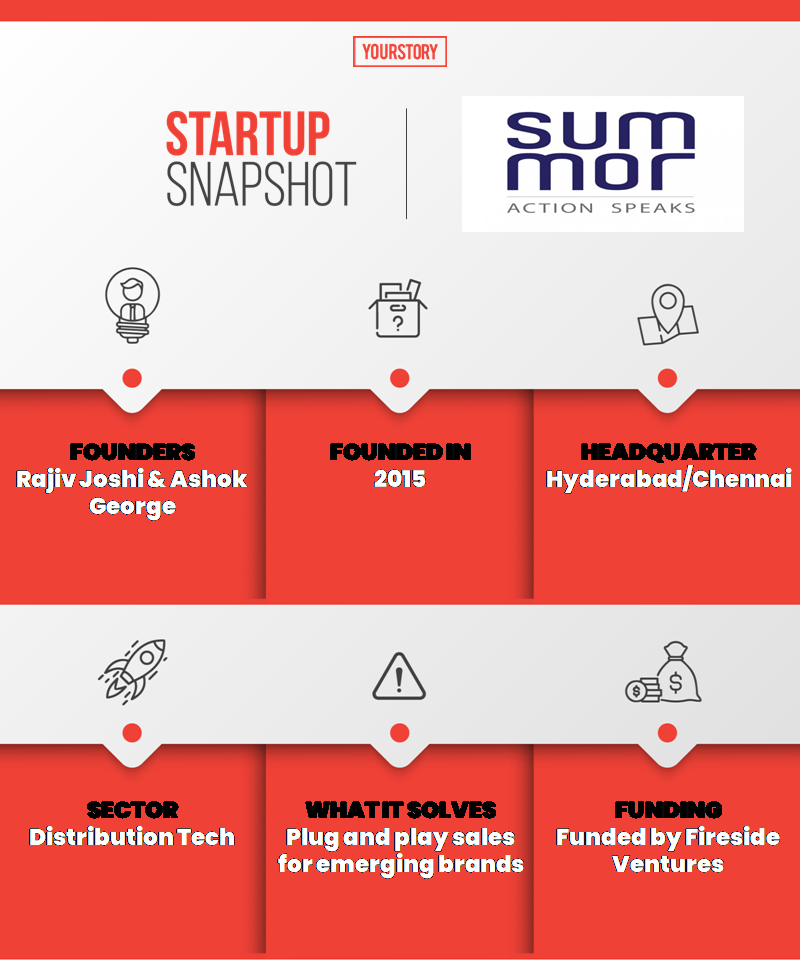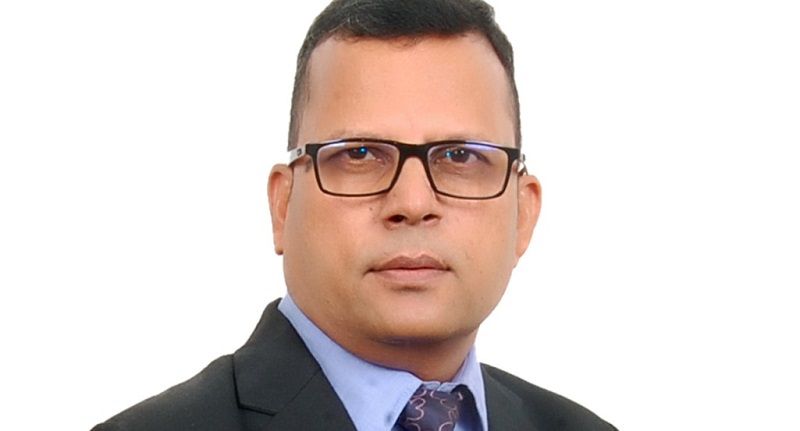They say sales and distribution (S&D) is a game meant only for big FMCG companies. But, with several challenger brands coming to the fore and making it big in ecommerce, smaller brands have realised that physical retail business simply cannot be ignored in India.
AnKa SumMor, founded by Ashok George and Rajiv Joshi in 2015, provides challenger brands the combined power of a large brand.
"Our S&D platform is for multiple challenger brands, thereby solving their S&D challenges of scale, information, and intelligence to optimally cater to demand at a reduced cost. For this, brands have to realise that not conventional distribution margin, but their overall S&D costs should be the benchmark. This platform will help significantly reduce S&D cost. Also, this notion of control needs to be questioned. What use is control without information and intelligence?" remarks Rajiv.
The startup is a single S&D partner platform for brands in a city, servicing all relevant retail channels/outlets. The platform services upcountry sub-distributors, eliminating the need for carrying and forwarding agents. The challenger brands directly supply to AnKa SumMor warehouses resulting in lower logistics costs
The frontline sales team on AnKa SumMor works with various brands, and eliminates the challenges of deploying, managing, and retaining teams independently. The platform claims to help brands with transparent order and sales information at any retail outlet level, and in the process, help plan the secondary sales for the brand. The platform improves order fill rates and lowers market expiries in six months.

"This results in revenue doubling in nine to 12 months, and there would be no trade scheme leakage, there will also be a reduction of S&D costs up to 50 percent," says Ashok George.
The early days
The founders have known each other for over 20 years now and have worked together at Coca-Cola and Mother Dairy in the past. The duo has a combined experience of over five decades in the S&D and logistics industry, especially in the FMCG industry.
The founders say the problem of finding, managing, and retaining distributors has been a constant challenge, coupled with the complexity of deploying and managing a large frontline sales team.
"In spite of all the effort and investment, the FMCG S&D system was always about fulfilling brand growth goals. We knew that in other parts of the world, S&D was a separate business. For instance, the Coca-Cola company does not bottle or distribute the brands directly, but has anchor bottlers. Mother Dairy’s strength came from its direct supplies to its booths, which was not the case the moment the company had to supply to retail," says Rajiv.

Rajiv Joshi, Co-founder, AnKa SumMor
The existing FMCG S&D system in India is multi-layered and fragmented. For instance, even big brands like HUL, Amul, Britannia, Nestle, and ITC have multiple distributors in any large city. This works for them as they have managed to create demand for their brands, resulting in significant revenue for each distributor.
However, these same brands struggle with their long tail, as the S&D system is geared to sell and distribute what sells. Imagine the plight of the No. 3, 4, or 5 (challenger) FMCG brands in the category. For one, large distributors are not interested due to lower demand, and this results in lower revenue, lower working capital rotation, and more importantly, higher damage and expiry in the market vis-à-vis the large brands. Two, small distributors do not make enough margin to support a salesman, resulting in the brand having to deploy their own frontline sales teams, and this becomes expensive. Also, lack of sufficient infrastructure and working capital to support growth, coupled with a high rate of logistics and distributor attrition, can lead to the brand being weakened and unable to compete with large brands.
S&D costs for these challenger FMCG brands are two to three times that of a large brand, leaving them with very little room to invest in the growth of the brand. Moreover, with all these costs, challenger brands do not have any visibility on order and sales from distributors to retailers, which results in trade scheme leakages, and poor SKU assortment along with damages and expiry. The brand's future is decided by the distributor and frontline salesman, a system that leads to the creation of large brands.
All experiments in FMCG S&D systems are limited to a Master Distributor and Sub Distributor model, which works only for big brands.
"New brands did not want to be stuck in a system that was created by bigger brands. They were willing to take a leap of faith, so came onboard with AnKa SumMor and have now clearly seen the benefit," says Rajiv.
The business model
The platform was funded and incubated by Fireside Ventures.
"The biggest challenge was the high cost of operations, stabilising end-to-end sales force automation, sales projections, and creating trust at retail during the first year, where the scale was still low for the infrastructure and resources deployed," says Ashok George.
AnKa SumMor has an inventory and working capital S&D Model, where ownership of stocks move to AnKa SumMor. Their revenues are sales to retail and they get S&D margins on the same. Since the startup buys a stock at a discounted rate, the discounts become their margins.
"All infrastructure for storage and delivery is hired and fixed, manpower is on company roles. Since most of the operating costs are fixed to semi-variable, revenue scale coupled with productivity enhancing technology will bring down operating cost as a percentage of revenue," says Rajiv.
The founders have invested over Rs 20 lakh in building the business from scratch. The startup has raised Rs 6 crore in a Seed round from Fireside Ventures. It has big plans over the next 18 months.
"We intend to raise Rs 13 crore in a combination of equity and debt during this year to fund our expansion to Bengaluru in early 2021 and increase infrastructure at Hyderabad and Chennai. The goal is to service 15,000 relevant outlets in these three cities by March 2022. We want to be profitable and generate Rs 100 crore revenue over the next two years. Subsequently, we want to raise Rs 100 crore to expand to the other metros and Tier I cities in India, with a distribution reach of 100,000 relevant outlets and plan to become a pan India operation in FY 2025," says Rajiv.

Ashok George, Co-founder of AnKa SumMor
He adds the startup will be further investing in deploying technology tools to automate warehouse and delivery operation and build an in-house data analytics engine. This will help create a recommendation engine to improve productivity at all levels and impact revenue growth for our brand partners, besides reducing operating costs and improving profitability.
The startup will continue to provide market insights for brands to leverage while developing consumer connect/demand for their customers by providing them data for hyper local marketing activities. It will add merchandising and promoter services to become a complete “Go to Market” solution for challenger brands. It will also create regional storage and logistics hubs for brand partners to improve stock rotation and lower logistics cost.
The brand currently directly services 2,100 outlets in Hyderabad and Chennai, and service over 20 sub-distributors in Telangana and Chennai. They intend to expand their reach to 5,000 outlets in Hyderabad and Chennai by March 2021.
The startup's revenues was Rs 18 crore in 2020, and is expecting to close FY 20-21 at Rs 24 crore. The company competes with Mobisy Technologies and JumboTail. Avendus predicts that D2C brands will have a $100 billion market by 2025.
There are nearly 600 D2C brands in India, and with the support of platforms like AnKa SumMor, these brands will see massive growth in the coming years.
Link : https://yourstory.com/2020/12/startup-anka-summor-sales-distribution-retail-brands
Author :- Vishal Krishna ( )
December 14, 2020 at 05:20AM
YourStory

